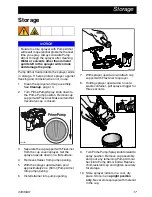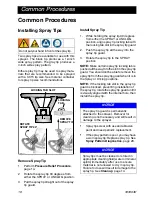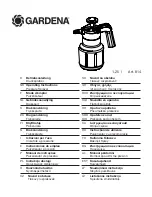
Important Safety Information
333394H
5
WARNING
FIRE AND EXPLOSION
HAZARD
Flammable fumes, such as solvent
and paint fumes, in work area can
ignite or explode. To help prevent fire
and explosion:
•
Sprayer generates sparks. Do not
spray or flush with flammable
liquids.
•
Use only non-flammable or
water-based materials, or
non-flammable paint thinners.
•
Keep spray area well-ventilated.
Keep a good supply of fresh air
moving through the area.
•
When spraying oil-based material, use
outdoors or in a well-ventilated indoor area
with a flow of fresh air.
•
Do not spray or flush with combustible
materials near an open flame or sources of
ignition.
•
Paint or solvent flowing through the
equipment is able to result in static
electricity. Static electricity creates a risk of
fire or explosion in the presence of paint or
solvent fumes.
•
Keep sprayer at least 10 in. (25 cm) away
from objects while spraying or flushing.
•
Verify all containers and collection systems
are grounded to prevent static discharge.
•
Connect to a grounded outlet and use
grounded extension cords. Do not use a 3 to
2 adapter.
•
Do not use paints or solvents containing
halogenated hydrocarbons.
•
Do not smoke in the spray area.
•
Do not operate light switches, engines, or
similar spark producing products in the
spray area.
•
Keep area clean and free of paint or
solvent containers, rags, and other
flammable materials.
•
Know the contents of the paints and
solvents being sprayed. Read all Material
Safety Data Sheets (MSDS) and container
labels provided with the paints and
solvents. Follow the paint and solvents
manufacturer’s safety instructions.
•
Fire extinguisher equipment shall be
present and working.
SKIN INJECTION HAZARD
High-pressure spray is able to inject
toxins into the body and cause serious
bodily injury. In the event that injection
occurs,
get immediate surgical
treatment.
•
Do not aim the sprayer at, or spray any
person or animal.
•
Keep hands and other body parts away
from the discharge. For example, do not
try to stop leaks with any part of the body.
•
Disconnect power when not spraying.
•
Always use the spray tip guard. Do not
spray without spray tip guard in place.
•
Use caution when cleaning and changing
spray tips. In the case where the spray tip
clogs while spraying, follow the
Pressure
Relief Procedure
, page 14 for relieving
the pressure before removing the spray tip
to clean.
•
Do not leave the unit energized or under
pressure while unattended. When the unit is
not in use, unplug the sprayer and follow the
Pressure Relief Procedure
, page 14.
•
Check parts for signs of damage.
Replace any damaged parts.
•
This system is capable of producing 2000
psi. Use replacement parts or
accessories that are rated a minimum of
2000 psi.
•
Do not carry the unit with a finger on the
trigger.
•
Verify that all connections are secure
before operating the unit.
•
Know how to stop the unit and bleed
pressure quickly. Be thoroughly familiar
with the controls.
ELECTRIC SHOCK HAZARD
This equipment must be grounded.
Improper grounding, setup, or usage
of the system can cause electric
shock.
•
Turn off and disconnect power cord before
servicing equipment.
•
Connect only to grounded electrical outlets.
•
Use only 3-wire extension cords.
•
Ensure ground prongs are intact on power
and extension cords.
•
Do not expose to rain or wet conditions.
Store indoors.
WARNING






































